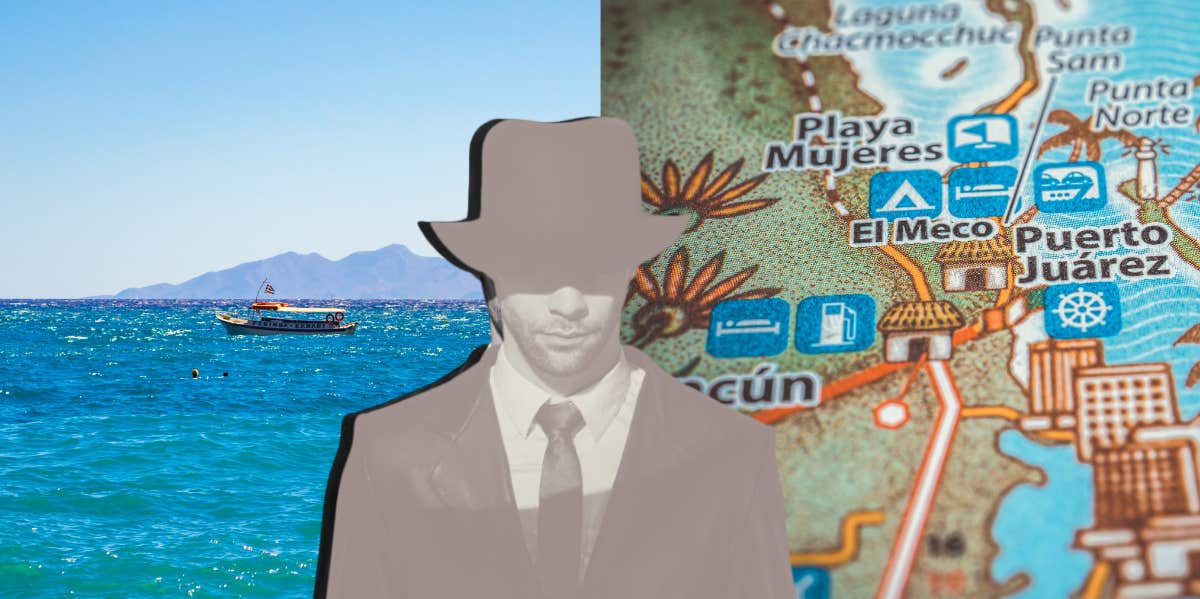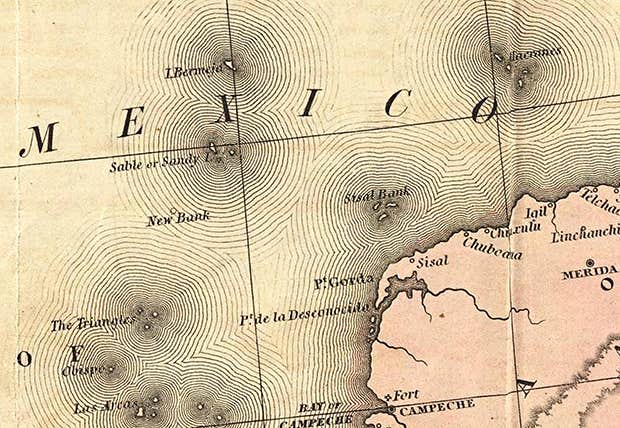The Strange Island Near Mexico That Suddenly Disappeared From Every Map
One century it was there, and the next it was gone.
 Anna Yordanova / Alexander Lukatskiy / Viktor Gladkov / Shutterstock
Anna Yordanova / Alexander Lukatskiy / Viktor Gladkov / Shutterstock There are so many strange and interesting places around that world, many that may be unfamiliar to you. Some are so obscure that no one has visited, and others, like the Bridgewater Triangle and Alaska Triangle, are cloaked in mystery due to rumors about suspicious disappearances.
But in the Gulf of Mexico, northwest of the Yucatán Peninsula, there used to be a small uninhabited Island called Bermeja. Legend has it that one century it was there and the next, it was completely gone, causing people to doubt the island existed at all.
What is Bermeja Island?
Bermeja Island, also known as Isla Bermeja, first appeared as a Spanish collection of islands created by Alonso de Santa Cruz, called El Yucatán e Islas Adyacentes, in the 16th century. But some time during the 21st century, it seemingly disappeared off the map, leaving fishermen and sailors confused.
An 1846 map showing Bermeja Island just off the coast was created by Henry S. Tanner and titled “A map of the United States of Mexico: as organized and defined by the several acts of the Congress of that Republic.”
Originally located at 22°33’N, 91°22’W, the phantom island appeared in maps showing the surrounding area. The lost island came to light in 2008 and 2009 when the United States and Mexico were negotiating drilling rights in areas of the Gulf of Mexico.
 Photo: Wikipedia
Photo: Wikipedia
Bermeja Island was an important area of the Exclusive Economic Zone (EEZ), and believed to hold an abundance of oil. Had it still existed, it would have been the northernmost Mexican island in the gulf. Its disappearance led to a loss of about 22.5 billion barrels of oil for Mexico.
The U.S. and Mexican governments negotiated a treaty in 1997 that divided Hoyos de Dona, a stretch of international waters where Bermeja was thought to have once been located. The Mexican government set out to find it in order to substantially extend their maritime limits and find oil deposits.
Though nothing was found, the treaty was signed. Three investigations took place in 2009, but despite searching all the way down to the ocean floor, no sign of the island was recovered.
After those failed attempts, the National Autonomous University of Mexico did maritime research to locate the vanishing island. They concluded that the island didn’t exist and found no proof that it ever had. But many people think it was there at some point and that its disappearance can be explained.
What happened to Bermeja Island?
There are several plausible, and not so plausible, explanations about what, if it ever existed, happened to Bermeja Island.
The CIA destroyed Bermeja Island.
There are two differing conspiracy theories that say the island was purposely destroyed by either the U.S. or Mexico.
For the United States, it is believed to have been leveled to keep Mexico from gaining vital territory. On Mexico’s part, they are believed to have obliterated the island to keep drug traffickers away. Neither theory has been confirmed.
Though it had shown up on maps for centuries, Bermeja was all but forgotten until the U.S. and Mexican governments began negotiations over oil around the Yucatán Peninsula in 1997.
A country's "sovereign right to the resources" extends 200 miles into the sea from the country's land border. That area is the EEZ mentioned above, and was codified by the United Nations (UN) in 1982 as the "Law of the Sea."
But in the area between the U.S. and Mexico, there were gaps to which neither country could lay claim. The 1997 negotiations were supposed to divide the orphan areas of the sea between the two. The plan made the area Bermeja was expected to be in Mexico's territory.
Excited, Mexico set out to find the lost island to no avail and consequently had to agree to less territorial rights than anticipated. But they were still hopeful as both countries had agreed to postpone any drilling projects until 2011, so Mexico still had time to prove Bermeja's existence and reverse the agreement.
This is where the theory, pushed by José Angel Conchello, a chairman of a major Mexican political party, about the U.S. destroying the island comes in. It centers around the idea that they would benefit from Bermeja's disappearance because it would limit Mexico's sovereign rights and extend theirs.
Conchello believed that the corrupt Mexican government had colluded with the United States to give up exploratory rights to U.S. companies. Months after making the accusation, he was run off the road and died, a crime that has never been solved.
In November 2000, six U.S. senators stated on the senate floor that they, too, thought the U.S. was culpable for the destruction of Bermeja. According to professors at the University of Mexico, this would have required a hydrogen bomb and only the U.S. had the motive and opportunity to do it.
Eroding soil caused the island to disappear.
Another explanation that is more plausible is that the soil on the island eroded over time until there was nothing there. That would explain the total disappearance of it, including any remnants that would remain.
There were shifts in the geological floor.
Some believe the island could have moved to a new location due to geological shifts. This theory is unlikely since researchers would have charted the movement and located some sign of the phantom island.
Rising sea levels swallowed up the island.
As sea levels have risen, some think it is totally possible that that mysterious Bermeja Island simply got swallowed up by the waters. It would, however, seem that if that were the case, the deep dive would have yielded some sort of findings.
The original map was bad cartography.
The existence of Bermeja Island could have been a mistake on the part of the cartographers. An analysis of the sea floor and Google Maps shows no indication of its existence.
Julio Zamora, President of the Mexican Society of Geography, said, "Countries making maps in the 16th and 17th centuries published them with inaccuracies to prevent their enemies from using them."
NyRee Ausler is a writer from Seattle, Washington who entertains and informs readers with in-depth analysis of conspiracy theories, legends, and myths.

